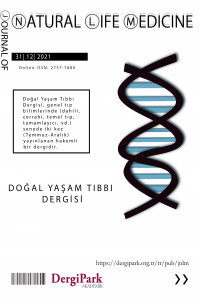Oftalmolojik Rahatsızlıklarda Yeni Bir Tanım: İhmal Edilen Göz Sendromu (İES-22)
Amaç: Fizyolojik sebepli ortaya çıkan lagoftalmi problemine yeni bir tanımlama getirerek, erken tanı ve doğru tedavi konusuna pozitif katkı sağlamaktır.
Tasarım: IES-22, dışlama ve tanı kriterleri belirlenirken diğer lagoftalmi sebepleri ile karşılaştırıldı ve tamamen ayrı bir tanımlama yapıldı. IES-22 kesin tanısı için dışlama kriterlerinin olmaması, majör kriterlerden en az 1, minör kriterlerinden en az 2 bulgu olması yeterli görüldü.
Metot: IES-22 dışlama kriterleri: Gözler, göz kapakları ve orbitada, lagoftalmiye neden olan herhangi bir patolojik durumun olması şeklinde belirlendi. IES-22 tanı kriterleri majör ve minör olarak ikiye ayrıldı. Majör kriterler primer, minör kriterler ise sekonder sebepler olarak kabul edildi. Majör kriterler: Göz kapakları küçüklüğü, konjenital exoftalmisi olmak, alt-üst göz kapaklarının birlikte veya ayrı ayrı limbus dışında alması, alt orbita kenarının normalden daha aşağıda alması ve iri gözlü olmak. Minör kriterler: Aile öyküsü olmak, ışık açıkken uyuyamamak, sabah ilk uyandığında; gözde yabancı cisim hissi, göz ağrısı bulunması ve gözde sulanma görülmesi, olarak belirlendi. Ayrıca, IES-22 derecelendirmesi; Grade I (hafif), Grade II (orta) ve Grade III (ağır) şeklinde yapıldı.
Sonuç: IES-22, göz açık uyuma vakalarında yeni bir tanımlama olabilir. Altta yatan her hangi bir hastalık olmaması ve uzun süre günlük yaşantımızı etkilememesi sebebiyle göz ardı edilme özelliğine sahiptir. Ayrıca IES-22 majör kriterleri içerisinde konjenital etkenlerin olması, genetik zeminli klinik araştırmalar yapılmasını da uygun kılmaktadır.
Anahtar Kelimeler:
IES-22, görmezlikten gelme, göz açık uyuma, göz bozuklukları
A New Definition in Ophthalmological Disorders: Ignored Eye Syndrome (IES-22)
Objective: To provide a positive contribution to early diagnosis and correct treatment by bringing a new definition to the problem of lagophthalmos that occurs due to physiological reasons.
Design: IES-22 was compared with other causes of lagophthalmos when determining exclusion and diagnostic criteria, and a completely separate definition was made. For the definitive diagnosis of IES-22, in the absence of exclusion criteria, at least 1 of the major criteria and at least 2 of the minor criteria were considered sufficient.
Metot: IES-22 exclusion criteria: It was defined as the presence of any pathological condition causing lagophthalmos in the eyes, eyelids, and eye orbit. The IES-22 diagnostic criteria were divided into major and minor. Major criteria were accepted as primary and minor criteria were considered as secondary causes. Major criteria: Small eyelids, congenital exophthalmos, protrusion of the lower and upper eyelids together or separately outside the limbus, the lower orbital rim of the eye than usual, and large eyes. Minor criteria: Having a family history, not being able to sleep with the light on, waking up first thing in the morning, foreign body sensation in the eye, presence of eye pain, and watering in the eye was determined. Also, the IES-22 rating; was performed as Grade I (mild), Grade II (middle), and Grade III (severe).
Conclusion: IES-22 may be a new definition in cases of sleeping with eyes open. Since there is no underlying disease and it does not affect our daily life for a long time, it has the feature of being ignored. In addition, the presence of congenital factors within the IES-22 major criteria makes it appropriate to conduct clinical studies based on genetics.
Keywords:
IES-22, ignored, lagophthalmia, ophthalmological disorders,
___
- Araújo JNM, Botarelli FR, Fernandes APNL, Oliveira-Kumakura ARS, Ferreira Júnior MA, Vitor AF.(2019). Predictive clinical factors for ocular dryness in patients admitted to the Intensive Care Unit. Rev Esc Enferm USP, 5,53.
- Arora T, Barbato M, Al Hemeiri S, Omar OM, AlJassmi MA. A mysterious sensation about sleep and health: the role of interoception. (2021). BMC Public Health, 21, 1584.
- ISSN: 2757-7880
- Yayın Aralığı: Yılda 2 Sayı
- Başlangıç: 2019
- Yayıncı: Hayrullah YAZAR
